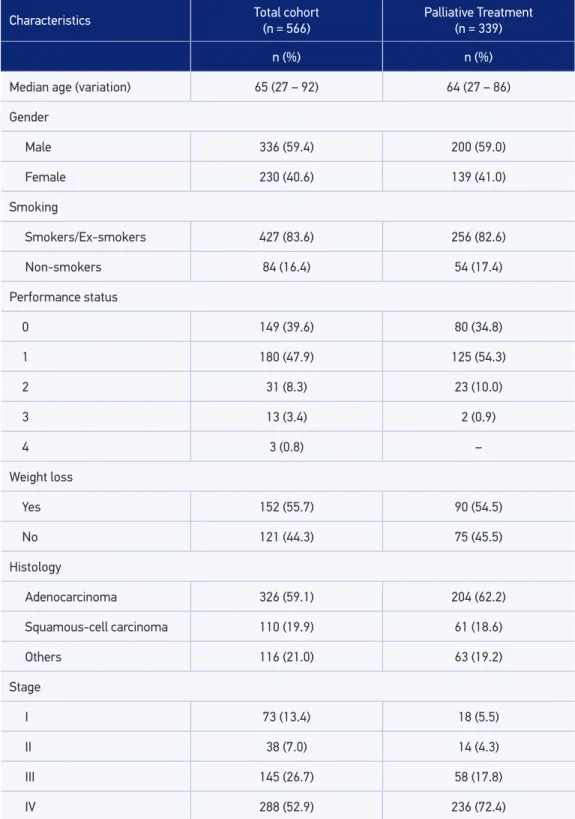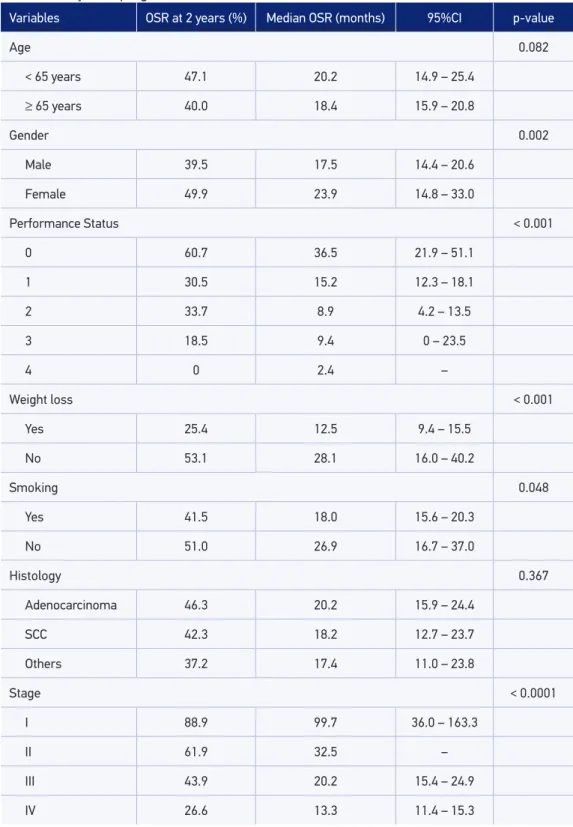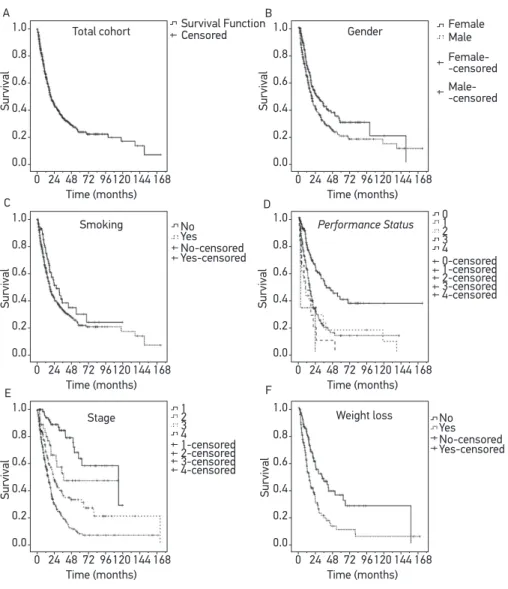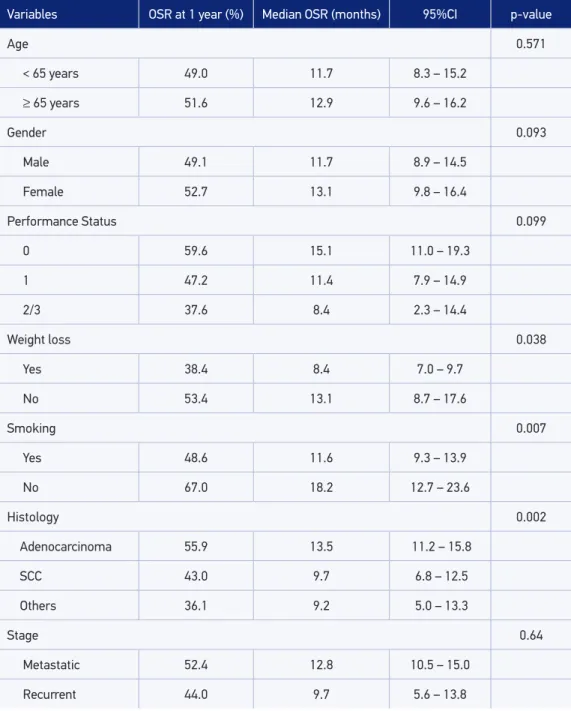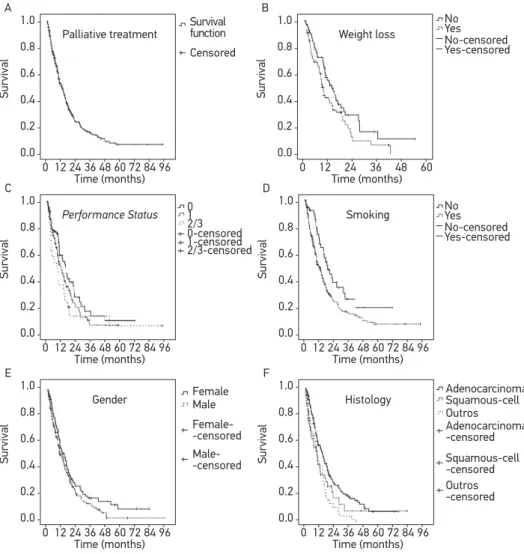ABSTRACT:Introduction: Outcomes data on Non-Small Cell Lung Cancer (NSCLC) are scarce with regard to the private health care in Brazil. The aim of this study was to describe the characteristics, treatments performed, and the survival of patients with NSCLC in a Brazilian private oncologic institution. Methods: Medical charts from patients treated between 1998 and 2010 were reviewed, and data were transferred to a clinical research form. Long-term follow-up and survival estimates were enabled through active surveillance. Results: Five hundred sixty-six patients were included, and median age was 65 years. Most patients were diagnosed in advanced stages (79.6% III/IV). The overall survival was 19.0 months (95%CI 16.2 – 21.8). The median survival was 99.7, 32.5, 20.2, and 13.3 months for stages I, II, III, and IV, respectively (p < 0.0001). Among patients receiving palliative chemotherapy, the median survival was 12.2 months (95%CI 10.0 – 14.4). Conclusions: The outcomes described are favorably similar to the current literature from developed countries. Besides the better access to health care in the private insurance scenario, most patients are still diagnosed in late stages. Keywords: Lung neoplasms. Epidemiology. Supplemental health. Neoplasm staging. Survival analysis. Treatment.
Survival and prognostic factors in patients with
Non-Small Cell Lung Cancer treated in private
health care
Sobrevida e fatores prognósticos em pacientes com câncer de pulmão de
células não pequenas assistidos na saúde suplementar
Luiz Henrique de Lima AraujoI, Clarissa Seródio BaldottoI, Mauro ZukinI,
Fernando Meton de Alencar Camara VieiraI, Ana Paula VictorinoI, Viviani Ribeiro RochaI, Rafaela Cordeiro HelalI, Jonas Hauben SalemI, Nelson TeichI, Carlos Gil FerreiraI
ICenter for Thoracic Oncology, Integrated Oncology Clinics (COI) and COI Institute for Education and Research – Rio de Janeiro (RJ), Brazil.
Corresponding author: Luiz Henrique de Lima Araujo. Instituto COI de Educação e Pesquisa. Avenida das Américas, 6.205, Loja E – Barra da Tijuca. CEP: 22793-080, Rio de Janeiro, RJ, Brasil. E-mail: luizaraujo@coinet.com.br
INTRODUCTION
Lung cancer is the malignant neoplasm of highest incidence worldwide1. According to
data from GLOBOCAN1, 1,095,200 new cases were estimated among men and 513,600 among
women in 2008. In developed countries, this incidence has been declining among men and remained stable among women, relecting the reduction in the rates of smoking among males2. It is also the leading cause of cancer-related death worldwide, with an estimated
951,000 deaths in males and 427,400 in females in 20081. These numbers are greater than
the sum of deaths from breast, prostate and colon cancer, and represent about 18% of all cancer deaths1.
In Brazil, lung cancer is the second most frequent cancer in men and fourth in women3, with 17,210 estimated new cases among men and 10,110 among women in 20123.
According to data from population-based registries4, the estimated risk between 2001
and 2005 was 29.08 new cases per 100,000 men and 11.49 per 100,000 women, taking the city of São Paulo as reference. It is still the leading cause of cancer-related death among men and the second leading among women, with 11,315 estimated deaths in males and 4,915 in females in 20035.
Unlike the U.S. data, the incidence and mortality in Brazil follow an upward curve, with progressively higher diagnostic and mortality rates. It is noteworthy that non-small cell lung cancer (NSCLC), the subject of this article, represents about 80% of
RESUMO:Introdução: Dados de desfechos em câncer de pulmão de células não pequenas (CPCNP) são escassos no contexto da saúde suplementar no Brasil. O objetivo deste estudo foi descrever as características, tratamentos realizados e a sobrevida desses pacientes em uma instituição oncológica privada brasileira. Métodos: Foram revisados os prontuários de pacientes atendidos entre 1998 e 2010 com diagnóstico de CPCNP. Os dados foram transferidos para uma ficha clínica individual e posteriormente analisados. Pacientes ou familiares foram contatados a fim de otimizar o seguimento e a estimativa da sobrevida. Resultados: Foram incluídos 566 pacientes, com idade mediana de 65 anos. Predominaram os diagnósticos em estádios avançados (79,6% III/IV). A sobrevida mediana foi de 19,0 meses (IC95% 16,2 – 21,8), sendo de 99,7, 32,5, 20,2 e de 13,3 meses nos estádios I, II, III e IV, respectivamente (p < 0,0001). Entre os pacientes que receberam quimioterapia paliativa, a sobrevida mediana foi de 12,2 meses (IC95% 10,0 – 14.4). Conclusões: Os desfechos encontrados se assemelham aos de países desenvolvidos. Apesar do maior acesso médico em pacientes com cobertura de planos de saúde, a maioria dos diagnósticos ocorre tardiamente.
cases and mainly comprises the adenocarcinoma, squamous cell carcinoma and large cell carcinoma subtypes6.
Most advances in the treatment of lung cancer came from international cooperative groups, which indicates the need to validate this information locally. Furthermore, data on outcomes in NSCLC were little explored in the context of private healthcare in Brazil so far. For this reason, we proposed a retrospective study in order to evaluate patients served at a Brazilian private health institution for a period of 12 years. This information is essential for the understanding of local outcomes and may guide the best allocation of resources in the medium term.
MATERIALS AND METHODS
DESIGN
This is a retrospective study conducted by evaluating medical records of patients diagnosed with NSCLC treated in a Brazilian private health institution. For data collection, a clinical form that included characteristics such as age, performance status (PS), presence and degree of weight loss, stage of disease at diagnosis, date of diagnosis, histological type, primary surgery (if performed) and current disease situation, was standardized.
PS was categorized from 0 to 4, according to the scale from the Eastern Cooperative Oncology Group (ECOG)7. Fully active and asymptomatic patients were categorized as
PS 0, while those with minimal symptoms were deined as PS 1. PS 2 was used to deine patients incapable of performing work activities and who remained seated or laid down for less than half the day. Bed-ridden patients or those who remained seated for more than half of the day, dependent on help for personal care activities, were deined as PS 3. PS 4 comprised completely incapable of self-care, bed-ridden patients.
The staging was deined according to the sixth edition of the American Joint Committee on Cancer (AJCC)8. Patients with malignant pleural or pericardial efusion (the old “wet”
OBJECTIVES AND VARIABLES
The primary objective of this study was to describe the basic characteristics and the treatments carried out. As secondary objectives, we analyzed the overall survival rate (OSR) of patients stratiied by tumor stage, and, in the subgroup of patients treated with palliative chemotherapy, estimated survival according to the presence of known prognostic factors.
STUDY POPULATION
Patients with NSCLC conirmed by pathological examination (histology or cytology) receiving care at the Integrated Oncology Clinics Group (COI) between December 1998 and June 2010 were included. The exclusion criteria deined was the presence of other concurrent malignancies within ive years preceding the diagnosis of lung cancer, except non-melanoma skin cancer and cervical cancer with more than three years of control. Also ineligible were patients who had received prior treatment for lung cancer at other institutions (public or private). These criteria are commonly used in the literature, and allow the reduction of selection biases that could impact the prognosis. The results are presented in two sections, the irst involving the entire study cohort represented by 566 patients, and the second comprising the subcohort treated with palliative chemotherapy, that included 339 patients.
STATISTICAL ANALYSIS
ETHICAL ASPECTS
This study was approved by the local research ethics committee and the non-use of an informed consent form was properly justiied. The ethical aspects are in accordance with the Resolution CNS 196/96 (DO. No. 201, October 16, 1996) and its complementary resolutions.
RESULTS
TOTAL COHORT
A total of 566 patients were included, with a median age of 65 years (ranging from 27 to 92). The majority were male (59.4%), of which 83.6% were smokers or ex-smokers. The most common histological type was adenocarcinoma, deined in 326 patients (59.1%), followed by squamous cell carcinoma in 110 cases (19.9%). Two hundred and eighty-eight patients (52.9%) were diagnosed with stage IV, while 145 (26.7%) with stage III, 38 (7.0%) in stage II and 73 (13.4%) in stage I. The basic characteristics are summarized in Table 1. One hundred and ifty-ive patients (28.1%) underwent surgery with curative intent. Of these, 67 (43.2%) were treated with adjuvant chemotherapy, and 23 (14.8%) with neoadjuvant. Palliative chemotherapy was used in 339 patients (59.9%), of which 166 (29.3%) also received second line chemotherapy. Two hundred eighty-seven patients (50.7%) were treated with radiotherapy at some time during the course of the disease, with the majority (188 cases) being carried out in palliation. Treatment data are presented in Table 2.
With a median follow-up of 12.8 months, median OSR was 19.0 months (95%CI 16.2 – 21.8). The median OSRs per stage were 99.7 months (95%CI 36.0 – 163.3), 32.5 months (95%CI = could not estimate), 20.2 months (95%CI 15.4 – 24.9) and 13.3 months (95%CI 11.4 – 15.3) in stages I, II, III and IV, respectively (p < 0.0001). The estimated OSR at 2 years was 88.9%, 61.9%, 43.9% and 26.6% in stages I, II, III and IV, respectively (Table 3 and Figure 1). Female patients also had greater survival rates (p = 0.002), as well as those with better PS (p < 0.001), no weight loss (p < 0.001) and no history of smoking (p = 0.048).
PATIENTS TREATED WITH PALLIATIVE CHEMOTHERAPY
Table 1. Baseline characteristics of patients evaluated between 1998 and 2010.
Characteristics Total cohort
(n = 566)
Palliative Treatment (n = 339)
n (%) n (%)
Median age (variation) 65 (27 – 92) 64 (27 – 86)
Gender
Male 336 (59.4) 200 (59.0)
Female 230 (40.6) 139 (41.0)
Smoking
Smokers/Ex-smokers 427 (83.6) 256 (82.6)
Non-smokers 84 (16.4) 54 (17.4)
Performance status
0 149 (39.6) 80 (34.8)
1 180 (47.9) 125 (54.3)
2 31 (8.3) 23 (10.0)
3 13 (3.4) 2 (0.9)
4 3 (0.8) –
Weight loss
Yes 152 (55.7) 90 (54.5)
No 121 (44.3) 75 (45.5)
Histology
Adenocarcinoma 326 (59.1) 204 (62.2)
Squamous-cell carcinoma 110 (19.9) 61 (18.6)
Others 116 (21.0) 63 (19.2)
Stage
I 73 (13.4) 18 (5.5)
II 38 (7.0) 14 (4.3)
III 145 (26.7) 58 (17.8)
being the most common (31.0%), followed by combination with pemetrexed (20.9%) and gemcitabine (17.4%).
With a median follow-up of 12.0 months, the median OSR was 12.2 months (95%CI 10.0 – 14.4). Survival was signiicantly higher among patients without weight loss (median 13.1 [95%CI 8.7 – 17.6] versus 8.4 months [95%CI 7.0 – 9.7], p = 0.038), no history of smoking (median 18.2 [95%CI 12.7 – 23.6] versus 11.6 months [95%CI 9.3 – 13.9], p = 0.007) and with adenocarcinoma histology (median 13,5 [95%CI 11.2 – 15.8] versus 9.7 months [95%CI 6.8 – 12.5] for squamous histology and 9.2 months [95%CI 5.0 – 13.3] for other histological subtypes, p = 0.002). Moreover, there was no diference in survival rates according to age (p = 0.571), gender (p = 0.093), Performance Status (p = 0.099) and stage (p = 0.64) (Table 4 and Figure 2).
DISCUSSION
The importance of prospective and retrospective records in lung cancer has been widely demonstrated in international examples9-11 and are essential today for a critical
and responsible analysis of the incorporation of new strategies and technologies in these countries. In Brazil, these tools gain additional importance with the need to demonstrate the true impact of these incorporations, as well as requiring cost-efectiveness and budget impact locally. In this project, 566 cases of NSCLC treated in a Brazilian private health institution were reviewed. This information will compose the basis for future comparisons, especially with the introduction of new technologies and the incorporation of the seventh AJCC classiication for staging.
Among the strengths of this study, we can highlight the long follow-up period and the relatively high number of patients. Furthermore, the use of an objective outcome such as OSR allowed a better access to data. As mentioned in Materials and Methods, active search by telephone was performed to optimize the tracking of information on follow-up and
Table 2. Treatment characteristics in patients evaluated between 1998 and 2010 (n = 566).
Type of treatment n (%)
Surgery with curative intent 155 (28.1)
Adjuvant chemotherapy 67 (11.8)
Neoadjuvant chemotherapy 23 (4.1)
Palliative chemotherapy 339 (59.9)
Radiotherapy* 287 (50.7)
Table 3. Analysis of prognostic factors in the total cohort (n = 566).
Variables OSR at 2 years (%) Median OSR (months) 95%CI p-value
Age 0.082
< 65 years 47.1 20.2 14.9 – 25.4
≥ 65 years 40.0 18.4 15.9 – 20.8
Gender 0.002
Male 39.5 17.5 14.4 – 20.6
Female 49.9 23.9 14.8 – 33.0
Performance Status < 0.001
0 60.7 36.5 21.9 – 51.1
1 30.5 15.2 12.3 – 18.1
2 33.7 8.9 4.2 – 13.5
3 18.5 9.4 0 – 23.5
4 0 2.4 –
Weight loss < 0.001
Yes 25.4 12.5 9.4 – 15.5
No 53.1 28.1 16.0 – 40.2
Smoking 0.048
Yes 41.5 18.0 15.6 – 20.3
No 51.0 26.9 16.7 – 37.0
Histology 0.367
Adenocarcinoma 46.3 20.2 15.9 – 24.4
SCC 42.3 18.2 12.7 – 23.7
Others 37.2 17.4 11.0 – 23.8
Stage < 0.0001
I 88.9 99.7 36.0 – 163.3
II 61.9 32.5 –
III 43.9 20.2 15.4 – 24.9
IV 26.6 13.3 11.4 – 15.3
A Total cohort Survival Survival Function No 0-censored 1-censored 2-censored 3-censored 4-censored 0 1 2 3 4 1 2 3 4 1-censored 2-censored 3-censored 4-censored Yes No-censored Yes-censored No Yes No-censored Yes-censored
Censored FemaleMale
Female--censored Male--censored Survival Survival Survival Gender Smoking Time (months) 0 24 48 72 96120 144 168 1.0 0.8 0.6 0.4 0.2 0.0 Performance Status B C D Survival Survival
Stage Weight loss
E F
Time (months) 0 24 48 72 96120 144 168 1.0 0.8 0.6 0.4 0.2 0.0 Time (months) 0 24 48 72 96120 144 168 1.0 0.8 0.6 0.4 0.2 0.0 Time (months) 0 24 48 72 96120 144 168 1.0 0.8 0.6 0.4 0.2 0.0 Time (months) 0 24 48 72 96120 144 168 1.0 0.8 0.6 0.4 0.2 0.0 Time (months) 0 24 48 72 96120 144 168 1.0 0.8 0.6 0.4 0.2 0.0
Figure 1. Survival curves in patients with Non-Small Cell Lung Cancer treated with palliative chemotherapy between 1998 and 2010 (A) according to gender (B), smoking status (C), Performance Status (D), staging (E), and weight loss (F) (n = 566).
death. We also decided to exclude patients who started treatment at other institutions. With that, we reduce the possibility of selection biases, since the information on patients with worse prognoses could be ignored. Furthermore, the data presented here indicate outcomes that are representative of daily practice, in contradiction to the environment of clinical trials, characterized by a restricted inclusion of patients12. Moreover, the long time
Table 4. Analysis of prognostic factors in patients treated with palliative chemotherapy (n = 339).
Variables OSR at 1 year (%) Median OSR (months) 95%CI p-value
Age 0.571
< 65 years 49.0 11.7 8.3 – 15.2
≥ 65 years 51.6 12.9 9.6 – 16.2
Gender 0.093
Male 49.1 11.7 8.9 – 14.5
Female 52.7 13.1 9.8 – 16.4
Performance Status 0.099
0 59.6 15.1 11.0 – 19.3
1 47.2 11.4 7.9 – 14.9
2/3 37.6 8.4 2.3 – 14.4
Weight loss 0.038
Yes 38.4 8.4 7.0 – 9.7
No 53.4 13.1 8.7 – 17.6
Smoking 0.007
Yes 48.6 11.6 9.3 – 13.9
No 67.0 18.2 12.7 – 23.6
Histology 0.002
Adenocarcinoma 55.9 13.5 11.2 – 15.8
SCC 43.0 9.7 6.8 – 12.5
Others 36.1 9.2 5.0 – 13.3
Stage 0.64
Metastatic 52.4 12.8 10.5 – 15.0
Recurrent 44.0 9.7 5.6 – 13.8
OSR: overall survival rate; SCC: squamous-cell carcinoma.
Figure 2. Survival curves in patients with Non-Small Cell Lung Cancer treated with palliative chemotherapy between 1998 and 2010 (A) according to weight loss (B), performance status (C), smoking status (D), gender (E), and histologic subtype (F) (n = 339).
A Palliative treatment Survival Time (months) 0-censored 1-censored 2/3-censored 0 1 2/3 No Yes No-censored Yes-censored Censored Survival function Female Male Female--censored Male--censored 0 12 24 36 48 60 72 84 96
1.0 0.8 0.6 0.4 0.2 0.0 C Performance Status Survival Time (months) 0 12 24 36 48 60 72 84 96 1.0 0.8 0.6 0.4 0.2 0.0 D Smoking Survival Time (months) 0 12 24 36 48 60 72 84 96 1.0 0.8 0.6 0.4 0.2 0.0 E Gender Survival Time (months) 0 12 24 36 48 60 72 84 96 1.0 0.8 0.6 0.4 0.2 0.0 F Histology Survival Time (months) 0 12 24 36 48 60 72 84 96 1.0 0.8 0.6 0.4 0.2 0.0 B Weight loss Survival Time (months) 0 12 24 36 48 60 1.0 0.8 0.6 0.4 0.2 0.0 Adenocarcinoma Squamous-cell Outros Adenocarcinoma -censored Squamous-cell -censored Outros -censored No Yes No-censored Yes-censored
In our survey, we found clinical characteristics and therapeutic strategies that are approximate to those described in developed countries. As an example, the median age found (65 years), the percentage of male patients (59.4%) and the percentage of nonsmokers (16.4%) are close to the data registered in countries like England and Canada9,10. Still, this
literature. The high rate of patients diagnosed at advanced stages (79.6% in stage III/IV) is a fact that raises interest. Although consistent with the literature, one would expect a higher proportion of patients with early diagnosis in the context of private health. As a rule, these patients have faster access to health care, as well as to examinations, compared to patients without health insurance coverage. This information also supports the need to prioritize primary prevention measures — such as anti-smoking campaigns — as well as early detection strategies.
The treatment used is in line with data from international registries. In fact, 155 patients analyzed in this study underwent surgery with curative intent, of which 67 (43.2%) received adjuvant chemotherapy. These proportions are similar to the Canadian data10 (Ontario
province), where the proportion of patients treated with adjuvant treatment was 31% after 2004. Accordingly, the median OSR among the patients studied here was 19.0 months; therefore, it is in live with data from developed countries9,10. We also found a signiicant
diference in survival rates according to stage at diagnosis. At this point, we emphasize the higher OSR of patients in stage I, which allows the projection of the impact of early screening programs that signiicantly increase the proportion of patients diagnosed at this stage. With the increasing cost of treatment of advanced lung cancer, efective strategies that lead to early detection — as imaging or biomarkers13,14 — and to the reduction of
the proportion of patients who develop metastatic disease can greatly reduce the expense of the health system intended to the treatment of this disease. Ultimately, this would allow ever-greater resources to be allocated for use in early diagnosis, prevention and support programs.
In this study, we also explored the characteristics and outcomes of patients undergoing palliative chemotherapy. Notably, the median survival rate reported (12.2 months) resembles that of developed countries and large clinical trials9,15,16. As an example,
the median survival rate reported in a clinical trial comparing two contemporary chemotherapy regimens was 10.3 months16. In our study, 48.9% of patients received
second-line therapy, which approximates the proportion of first-line therapy mentioned in clinical trials17. On the other hand, the survival rate is much higher than that of public
health services in Brazil, where median survival rates in the range of 7.1 months were described18. In this sense, some factors may have interfered, among which stands out
CONCLUSION
Patients treated in a Brazilian private oncologic institution had characteristics and outcomes similar to those described in developed countries. A high proportion of patients diagnosed at advanced stages raises interest to the need of prioritizing measures for primary prevention (such as tobacco control campaigns), as well as new strategies for early diagnosis. The survival rates of patients treated with palliative chemotherapy is similar in data from international literature and shows to be superior to national public health services.
1. Jemal A, Bray F, Center MM, Ferlay J, Ward E, Forman D.. Global Cancer Statistics. CA Cancer J Clin 2011; 61(2): 69-90.
2. Siegel R, Naishadam D, Jemal A. Cancer statistics 2012. CA Cancer J Clin. 2012; 62(1): 10-29.
3. Instituto Nacional de Câncer / Ministério da Saúde. Estimativa 2012: incidência de câncer no Brasil. Rio de Janeiro: INCA. http://www.inca.gov.br. (acesso em 07/06/2013).
4. Câncer no Brasil: Dados dos Registros de Câncer de Base Populacional, Volume IV (2010) MS/INCA/ Conprev/Divisão de Informação. http://www.inca. gov.br. (acessado em 7 de junho de 2013).
5. Instituto Nacional de Câncer / Ministério da Saúde. Estimativa da Incidência e Mortalidade por Câncer no Brasil 2003. Rio de Janeiro: INCA. http://www. inca.gov.br (acessado em 07 de junho de 2013).
6. Travis WD. Pathology of lung cancer. Clin Chest Med 2002; 23(1):65- 81.
7. Oken MM, Creech RH, Tormey DC, Horton J, Davis TE, McFadden ET, et al. Toxicity and Response Criteria of the Eastern Cooperative Oncology Group. Am J Clin Oncol 1982; 5(6): 649-55.
8. Thorax. In: Edge SB. American Joint Comission on Cancer. Cancer Staging Handbook (Springer), 6th edition, 2002: 189-210.
9. Rich AL, Tata LJ, Stanley RA, Free CM, Peake MD, Baldwin DR, et al. Lung cancer in England: information from the National Lung Cancer Audit (LUCADA). Lung Cancer 2011; 72(1): 16-22.
10. Booth CM, Shepherd FA, Peng Y, Darling GE, Li G, Kong W, et al. Adoption of adjuvant chemotherapy for non-small-cell lung cancer: a population-based outcomes study. J Clin Oncol 2010; 28(21): 3472-8.
11. Kawagushi T, Matsumura A, Fukai S, Tamura A, Saito R, Zell JA, et al. Japanese ethnicity compared with caucasian ethnicity and never-smoking status are independent favorable prognostic factors for overall survival in non-small cell lung cancer: a collaborative epidemiolog ic study of the National Hospital Organization Study Group for Lung Cancer (NHSGLC) in Japan and a Southern California Regional Cancer Registry databases. J Thorac Oncol 2010; 5(7): 1001-10.
12. Berger ML, Mamdani M, Atkins D, Johnson ML. Good research practices for comparative efectiveness research: def ining, reporting and inter preting nonrandomized studies of treatment efects using secondary data sources: the ISPOR Good Research Practices for Retrospective Database Analysis Task Force Report – part I. Value Health 2009; 12(8): 1044-52.
13. The National Lung Screening Trial Research Team. Reduced Lung-Cancer Mortality with Low-Dose Computed Tomographic Screening. N Engl J Med 2011; 365(5): 395-409.
14. Hassanein M, Callison JC, Callaway-Lane C, Aldrich MC, Grogan EL, Massion PP. The state of molecular biomarkers for the early detection of lung cancer. Cancer Prev Res (Phila). 2012; 5(8): 992-1006.
15. Schiller JH, Harrington D, Belani CP, Langer C, Sandler A, Krook J, et al. Comparison of four chemotherapy regimens for advanced Non–Small-Cell Lung Cancer. N Engl J Med 2002; 346(2): 92-8.
16. Scagliotti GV, Parikh P, von Pawel J, Biesma B, Vansteenkiste J, Manegold C, et al. Phase III study comparing cisplatin plus gemcitabine with cisplatin plus pemetrexed in chemotherapy-naive patients with advanced-stage Non–Small-Cell Lung Cancer. J Clin Oncol 2008; 26(21): 3543-51.
17. Hensing TA, Schell MJ, Lee JH, Socinski MA. Factors associated with the likelihood of receiving second line therapy for advanced non-small cell lung cancer. Lung Cancer 2005; 47(2): 253-9.
18. Andrade CJ, Ferreira CG, Pereira JL, Porto AL, Freitas ED, Adriano HC, et al. Outcome of advanced non-small cell lung cancer patients treated in a single institution with irst generation platinum doublets. Using a retrospective analysis to help decisions in resource allocation. Proc Am Soc Clin Oncol 2005; 23(16S): (abstr 7342).
19. Shepherd FA, Dancey J, Ramlau R, Mattson K, Gralla R, O’Rourke M, et al. Prospective randomized trial of docetaxel versus best supportive care in patients with non-small-cell lung cancer previously treated with platinum-based chemotherapy. J Clin Oncol 2000; 18(10): 2095-103.
Received on: 03/18/2013
